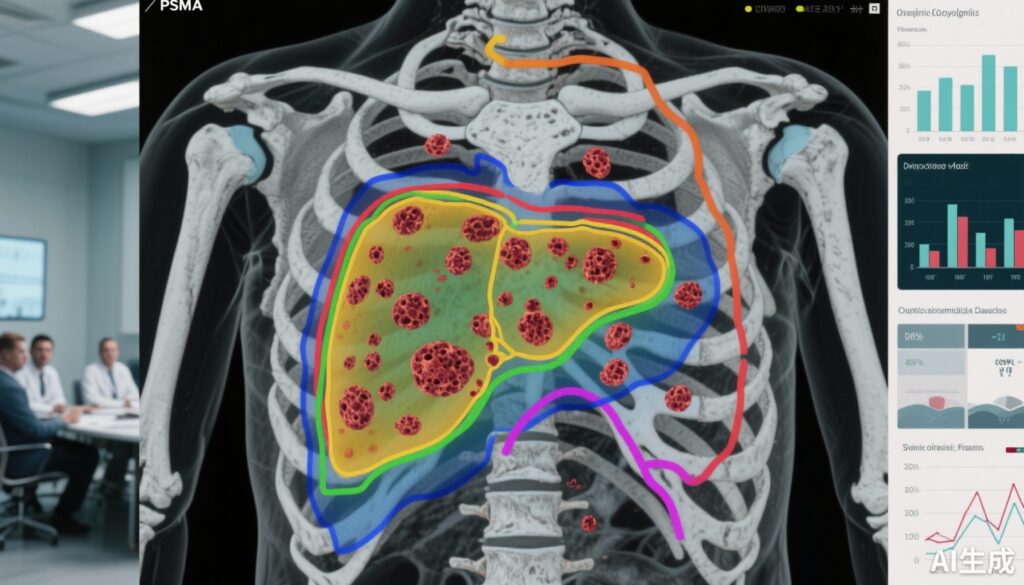Highlights
– Baseline PSMA-PET total tumour volume (PSMA‑TTV) was strongly prognostic for overall survival (OS) in high‑risk, first‑line metastatic castration‑resistant prostate cancer (mCRPC) treated with enzalutamide.
– PSMA‑TTV predicted a larger OS benefit from adding 177Lu‑PSMA‑617 to enzalutamide (interaction p=0.0078); patients with PSMA‑TTV above the median derived particular survival advantage.
– PSMA SUVmean (highest quartile vs lower three quartiles) was not prognostic or predictive for OS or PSA progression‑free survival in this substudy.
Background
Metastatic castration‑resistant prostate cancer (mCRPC) remains a leading cause of cancer mortality among men. Recent trials have established radioligand therapy with lutetium‑177 labelled prostate‑specific membrane antigen ligand (177Lu‑PSMA‑617) as an effective systemic option in patients with PSMA‑avid disease, improving survival when added to standard care in appropriately selected populations. However, heterogeneity in treatment benefit remains, and imaging biomarkers that refine patient selection and prognosis are needed.
PSMA PET‑CT provides both qualitative and quantitative measures of tumour burden and tracer uptake. Two quantitative parameters have attracted attention: whole‑body PSMA total tumour volume (PSMA‑TTV), a volumetric measure of PSMA‑avid disease, and standardized uptake value metrics such as SUVmean or SUVmax that reflect tracer avidity. Prior work suggested that larger PSMA‑TTV is associated with worse outcomes, whereas greater tracer uptake may correlate with response to PSMA‑targeted therapy; nevertheless, robust prospective data evaluating prognostic and predictive value of these metrics in randomised settings have been limited.
Study design (ENZA‑p substudy)
The ENZA‑p (ANZUP1901) multicentre, open‑label, randomised phase 2 trial enrolled men with progressive mCRPC who had not previously received docetaxel or androgen receptor (AR) pathway inhibitors for mCRPC (abiraterone allowed), had PSMA PET‑positive disease, ECOG 0–2, and at least two pre‑specified risk factors for early progression on enzalutamide. Between August 2020 and July 2022, 162 participants were randomised 1:1 to enzalutamide 160 mg daily alone or enzalutamide plus adaptive‑dosed intravenous 177Lu‑PSMA‑617 (7.5 GBq per dose, two or four doses, administered every 6–8 weeks).
All participants underwent baseline 68Ga‑PSMA‑11 PET‑CT for eligibility; centralised semi‑automated quantification derived PSMA‑TTV and whole‑body SUVmean. The substudy predefined thresholds: PSMA‑TTV dichotomized at the cohort median (234 mL) and SUVmean dichotomized as highest quartile (Q4) versus lower three quartiles (Q1–3). The primary endpoint for the substudy was overall survival (OS); analyses used Kaplan–Meier estimates and Cox regression, analysing patients by treatment received. The parent trial primary endpoint of PSA progression‑free survival has been reported separately. Trial registration: ClinicalTrials.gov NCT04419402.
Key findings
Of 162 randomised patients, 160 received study treatment and were included in the imaging substudy analysis (79 enzalutamide, 81 enzalutamide plus 177Lu‑PSMA‑617). Median follow‑up at final data cutoff (31 July 2024) was 34 months (IQR 29–39). There were 96 OS events (53 in enzalutamide, 43 in combination arm). Baseline median PSMA SUVmean was 7.7 (IQR 6.5–9.8) and median PSMA‑TTV was 234 mL (IQR 76–687).
Prognostic value of PSMA‑TTV
PSMA‑TTV was a strong prognostic marker in the enzalutamide‑alone arm: median OS for patients with PSMA‑TTV below the median was 39 months (95% CI 31–not estimable) versus 20 months (95% CI 13–24) for those with PSMA‑TTV above the median (hazard ratio [HR] 0.23, 95% CI 0.13–0.42; log‑rank p<0.0001). In the combination arm the difference was attenuated: median OS 35 months (95% CI 32–37) for PSMA‑TTV below median versus 28 months (95% CI 26–34) for PSMA‑TTV above median (HR 0.66, 95% CI 0.36–1.21; log‑rank p=0.18).
Predictive interaction: PSMA‑TTV and treatment effect
Importantly, there was a statistically significant interaction between baseline PSMA‑TTV and treatment assignment for OS (interaction p=0.0078), indicating that PSMA‑TTV modified the effect of adding 177Lu‑PSMA‑617 to enzalutamide. In plain terms, patients with higher PSMA‑TTV (above median) appeared to derive greater relative overall‑survival benefit from receiving combination therapy compared with enzalutamide alone, whereas those with lower PSMA‑TTV derived less incremental OS benefit.
PSMA SUVmean: neither prognostic nor predictive
Using the prespecified dichotomy (SUVmean Q4 vs Q1–3), SUVmean did not significantly stratify OS in either treatment arm. In the enzalutamide group, median OS was 29 months (95% CI 17–39) for Q4 vs 25 months (95% CI 21–31) for Q1–3 (HR 0.84, 95% CI 0.44–1.60; p=0.59). In the combination arm, median OS was 32 months (95% CI 21–not estimable) for Q4 vs 34 months (95% CI 27–35) for Q1–3 (HR 0.80, 95% CI 0.38–1.68; p=0.56). The interaction test between SUVmean category and treatment was non‑significant (p=0.88).
Other clinical endpoints and safety
The primary trial reported improved OS with addition of 177Lu‑PSMA‑617 to enzalutamide across the study population; this substudy focused on imaging biomarkers rather than safety. No new safety signals attributable to selection by PSMA PET metrics were reported in the parent publication. Detailed adverse event breakdowns are presented in the parent trial report.
Expert commentary and interpretation
This prespecified imaging substudy provides high‑quality prospective evidence that volumetric PSMA PET metrics—specifically whole‑body PSMA‑TTV—carry both prognostic and predictive information in the first‑line treatment of high‑risk mCRPC. The strong prognostic discrimination observed in the enzalutamide arm (median OS 39 vs 20 months) underscores that PSMA‑TTV reflects disease burden and biology not fully captured by conventional clinical indices.
Most clinically relevant is the interaction between PSMA‑TTV and treatment effect: patients with higher PSMA‑TTV appeared to benefit more from adding 177Lu‑PSMA‑617 to enzalutamide. This supports a rationale for using PSMA‑TTV to prioritise radioligand therapy for patients with high volumetric PSMA‑positive tumour burden, where the incremental survival gain is larger. Conversely, patients with low PSMA‑TTV had favorable prognosis on enzalutamide alone and might be spared early radioligand therapy, though individual decision‑making should weigh other factors.
The lack of prognostic or predictive value for SUVmean in this cohort contrasts with some earlier, smaller retrospective reports suggesting tracer avidity may correlate with response to PSMA‑targeted therapy. Possible explanations include differences in SUV metric definitions, heterogeneity of uptake within lesions, partial‑volume effects in small lesions, and the fact that volumetric burden may be a dominant determinant of outcome in first‑line mCRPC.
Biological plausibility
PSMA‑TTV integrates both lesion count and size across disease sites and therefore reflects overall tumour burden and the spatial distribution of PSMA‑expressing disease. Higher volumetric burden may indicate greater radiosensitive target mass for 177Lu‑PSMA‑617 to act upon, but also represents a worse baseline prognosis; the observed larger absolute benefit from radioligand in high‑TTV patients likely combines these factors.
Limitations and generalisability
Limitations include the phase 2 nature of ENZA‑p and that the substudy population comprised high‑risk mCRPC patients meeting specific PSMA PET eligibility thresholds (SUVmax criteria), which may limit generalisability to broader mCRPC cohorts. The PSMA‑TTV threshold used was the cohort median and may not be universally applicable; external validation and standardized segmentation protocols are required before routine clinical implementation. Additionally, imaging quantification was performed with specific semi‑automated software and methodological variability across platforms may affect reproducibility.
Clinical implications and next steps
These data support incorporation of baseline PSMA‑TTV into risk stratification and shared decision‑making for first‑line treatment of high‑risk mCRPC. In practice, patients with large PSMA‑TTV could be prioritised for early addition of 177Lu‑PSMA‑617 to AR‑targeted therapy, whereas those with low PSMA‑TTV might reasonably start AR‑directed therapy alone with close monitoring.
Before adoption into guidelines, prospective validation in independent datasets and harmonisation of PSMA‑TTV measurement are needed. Future studies should evaluate optimal TTV cutpoints, assess integration with other prognostic markers (e.g., circulating tumour DNA, ALP, LDH), and determine whether PSMA‑TTV predicts differential benefit for other systemic combinations.
Conclusion
The ENZA‑p imaging substudy demonstrates that baseline PSMA‑TTV is a robust prognostic biomarker in first‑line high‑risk mCRPC and is predictive of enhanced overall survival benefit from adding 177Lu‑PSMA‑617 to enzalutamide. PSMA SUVmean did not provide added prognostic or predictive value in this population. These findings advance imaging‑based personalised therapy for mCRPC but require external validation and standardisation of volumetric PET quantification prior to widespread clinical implementation.
Funding and trial registration
Funding: The Prostate Cancer Research Alliance initiative (Movember and Australian Federal Government), Prostate Cancer Foundation Challenge Award, St Vincent’s Clinic Foundation, GenesisCare, RoyMorgan, Endocyte (a Novartis company), and Astellas. Trial registration: ClinicalTrials.gov NCT04419402.
References
1. Emmett L, Papa N, Subramaniam S, et al; ENZA‑p Trial Investigators and ANZUP. Prognostic and predictive value of baseline PSMA‑PET total tumour volume and SUVmean in metastatic castration‑resistant prostate cancer in ENZA‑p (ANZUP1901): a substudy from a multicentre, open‑label, randomised, phase 2 trial. Lancet Oncol. 2025 Sep;26(9):1168–1177. doi:10.1016/S1470-2045(25)00339-0.
2. Sartor O, de Bono J, Chi KN, et al. Lutetium‑177‑PSMA‑617 for Metastatic Castration‑Resistant Prostate Cancer. N Engl J Med. 2021;385(12):1091–1103.
3. Hofman MS, Violet J, Hicks RJ, et al. [TheraP trial] 177Lu‑PSMA‑617 versus cabazitaxel in patients with metastatic castration‑resistant prostate cancer (TheraP): an open‑label, randomised, phase 2 trial. Lancet. 2021;397(10276):797–804.
Note: Full methodological details, safety data, and primary trial endpoints are available in the parent ENZA‑p trial publications and trial registry (NCT04419402).



